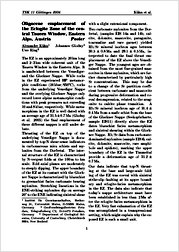| dc.contributor.author | Kühn, Alexander | |
| dc.contributor.author | Glodny, Johannes | |
| dc.contributor.author | Ring, Uwe | |
| dc.contributor.editor | Philipp, Sonja | |
| dc.contributor.editor | Leiss, Bernd | |
| dc.contributor.editor | Vollbrecht, Axel | |
| dc.contributor.editor | Tanner, David | |
| dc.contributor.editor | Gudmundsson, Agust | |
| dc.date.accessioned | 2010-11-26T13:21:09Z | |
| dc.date.accessioned | 2013-01-28T10:19:37Z | |
| dc.date.available | 2010-11-26T13:21:09Z | |
| dc.date.available | 2013-01-28T10:19:37Z | |
| dc.date.issued | 2006-03 | |
| dc.identifier.citation | Philipp, S.; Leiss, B; Vollbrecht, A.; Tanner, D.; Gudmundsson, A. (eds.): 11. Symposium "Tektonik, Struktur- und Kristallingeologie"; 2006, Univ.-Verl. Göttingen, p. 122 - 123. | |
| dc.identifier.isbn | 3-938616-40-7 | |
| dc.identifier.uri | http://hdl.handle.net/11858/00-1735-0000-0001-341E-6 | |
| dc.description.abstract | The EZ is an approximately 20km long
and 2–3km wide coherent unit of the
Tauern Window in the Eastern Alps. It
is sandwiched between the Venedigerand
the Glockner Nappe. While rocks
in the EZ experienced HP metamorphic
conditions (24 kbar/650°C), rocks
from the underlying Venediger Nappe
and the overlying Glockner Nappe only
record lower alpine metamorphic conditions
with peak pressures not exceeding
10 and 8 kbar, respectively. While metamorphism
in the EZ is well dated with
an average age of 31.5±0.7Ma (Glodny
et al. 2005) the final emplacement of
these different nappes is still under debate.
Our Rb-Sr-data indicate that top-N thrusting
at the base and large-scale folding
of the EZ was coeval with sinistral
strike-slip faulting at its upper boundary
and eclogite-facies metamorphism
in the EZ. The data also indicate that
today’s nappe architecture must have
been established in less than 2Ma after
the eclogite facies metamorphism in
the EZ. Very fast exhumation of the EZ
was accomplished in a transpressional
setting, which might explain why the exposed
EZ is such a small unit. | |
| dc.format.mimetype | application/pdf | |
| dc.language.iso | deu | |
| dc.publisher | Universitätsverlag Göttingen | |
| dc.relation.ispartof | 11. Symposium "Tektonik, Struktur- und Kristallingeologie" | |
| dc.subject.ddc | 551 | |
| dc.subject.gok | VEB 163 | |
| dc.subject.gok | VKB 291 | |
| dc.subject.gok | VAE 400 | |
| dc.subject.gok | VBN 500 | |
| dc.subject.gok | VAE 811 | |
| dc.title | Oligocene emplacement of the Eclogite Zone of the central Tauern Window, Eastern Alps, Austria | |
| dc.type | anthologyArticle | |
| dc.subject.gokverbal | Zentrale Ostalpen {Geologie} | |
| dc.subject.gokverbal | Metamorphe Komplexe, Alpen {Petrologie} | |
| dc.subject.gokverbal | Tektogenese {Geologie} | |
| dc.subject.gokverbal | Geochronologie einzelner Regionen im allgemeinen | |
| dc.subject.gokverbal | Alpidische Orogene {Geologie} | |
| dc.bibliographicCitation.firstPage | 122 | |
| dc.bibliographicCitation.lastPage | 123 | |
| dc.identifier.doi | 10.23689/fidgeo-1833 | |
| dc.type.version | publishedVersion | |
| dc.subject.free | Tauernfenster | |
| dc.subject.free | Decke <Geologie> | |
| dc.subject.free | Eklogit | |
| dc.subject.free | Rubidium-Strontium-Methode | |
| dc.subject.free | Überschiebung | |
| dc.subject.free | Oligozän | |
| dc.relation.collection | Geologische Wissenschaften | |
| dc.description.type | conference | |


